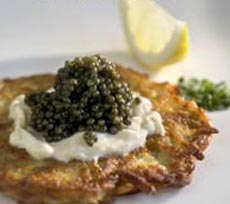

A popular base for caviar is a potato pancake and a dab of crème fraîche. Photograph courtesy of Tsar Nicoulai Cafe in the Ferry Building, San Francisco.
April 2005
|
 |
Caviar Buying & Serving Tips
It’s Easy To Do It Right
Here are some of our favorite tips for serving caviar. If you have any of your own caviar tips to add, click on the link to send them to us.
| PURCHASE |
- Price is no indicator of quality. Top dollar does not guarantee top quality; however, often bargain caviar is no bargain. If you don’t know the provisioner and have no personal reference, Caspian and other fine caviar is an expensive and risky purchase sight-unseen. Since caviar is a special occasion purchase, you may be better off spending more with a trusted source.
- When purchasing in person, a caviar specialist will open the tin (not a vacuum-sealed jar) to show you the roe. The caviar should smell fresh, with no off odor. The eggs should be whole, not broken. If you are offered a taste from a sample tin (which most merchants do not do, given the cost of goods), the caviar should be crisp and pop when pressed to the roof of the mouth with the tongue.
- One way to become more familiar with the qualities of fine caviar is to try it at restaurants that specialize in it. We’ve begun a list in this section. You’ll likely be able to compare different caviars side by side; and your captain will be glad to guide you.
|
| STORAGE |
- Caviar is very perishable and must be handled with care. Keep it in the coldest part of the refrigerator, generally the back.
- Fresh caviar (not pasteurized) can be kept unopened in the refrigerator for 4 weeks in a vacuum-sealed jar, two weeks in a tin.
- Caviar distributors can store the product at the ideal temperature (about 26° F, just above caviar’s freezing point); but home refrigerators are too warm and home freezers are too cold. You can extend its life for a couple of weeks by wrapping the jar or tin in a plastic bag and setting it in a bowl of ice. Change the ice frequently as it melts.
- Never freeze sturgeon caviar—it will lose its consistency. You can freeze salmon, whitefish and trout caviars; but once defrosted, do not re-freeze them.
|
| CONSUMPTION |
- Consume uneaten caviar within three days of opening. It can be eaten after that, but it starts to deteriorate.
|
| SERVING |
- Take caviar out of the refrigerator 10-15 minutes before serving.
- If you’re presenting the caviar on a buffet or a cocktail table and you don’t have a caviar server that holds ice, keep the caviar in its original jar or tin, set in a bowl of crushed ice.
|
| SPOONS |
- Use mother-of-pearl, bone, wood, or enamel spoons. Caviar tastes metallic when eaten off stainless or silver spoons.
- If you are making hors d’oeuvres in the kitchen, you can also use a plastic spoon.
|
| BASES FOR CAVIAR |
- Classic bases are blinis and crustless toasted white bread or brioche squares or triangles. Some people lightly butter the blini or toast; others consider this overkill. If you want to butter, brush on melted butter with a pastry brush.
- Creative bases are boiled potato slices; mini latkes, toasted challah, and hard boiled egg slices (one way to keep the yolk and white from separating is to rest the egg slice upon a thin cucumber slice. Crunchier and saltier caviars also work well on daikon (Japanese radish) slices. Although more labor intensive, caviar looks very attractive in scooped-out cucumber, potato, and quail egg cups.
- An elegant presentation is a boiled egg (at room temperature) with the top snipped off. Half of the egg is scooped out; the space is filled with salmon or paddlefish caviar and topped with crème fraîche and some tiny snipped chives. You can serve it in an egg cup or anchor it on a plate in a mound of wet Kosher salt, decorated with strands of chives.
- Don’t serve crackers or fine potato chips with caviar—the hard texture is inappropriate for the delicate eggs.
|
| GARNISH |
- With high quality caviars, use a dab of crème fraîche, which marries the buttery rich caviar and the toast or blini as well as the saltiness of the caviar with the fruitiness of champagne. Sour cream can substitute if crème fraîche is unavailable.
- Chopped eggs, capers and chopped onions are never used with high quality caviars—they mask the subtle qualities you are seeking in the caviars. Their purpose is to enhance lower-quality roes that lack good caviar flavor (not to be confused with less expensive kinds of roe, e.g. salmon or whitefish, that have excellent flavor for their particular variety of roe).
|
| TECHNIQUE |
- To fully appreciate the flavor and texture of fine caviar, you should “burst” the eggs with the tip of your tongue against your palate to release the flavor in your mouth.
|
| BEVERAGES |
- The classic pairings are dry Champagne (a style with a heavy pinot noir concentration works best with sturgeon caviars) and chilled vodka.
- With salmon, whitefish and trout caviars try Chablis or Gruner Veltliner.
- Beer lovers can enjoy a lager or a crisp wheat beer—avoid anything dark that will overwhelm the subtle caviar flavors.
|
| MAIN DISHES |
- Caviar can be used to garnish fish, soups, sauces, vinaigrettes, dips, and other dishes. Check both this section of TheNibble.com and recipe reference sources for the many creative ways you can use caviar in your menus.
|
Lifestyle Direct, Inc. All rights reserved. Images are the copyright of their individual owners.

|